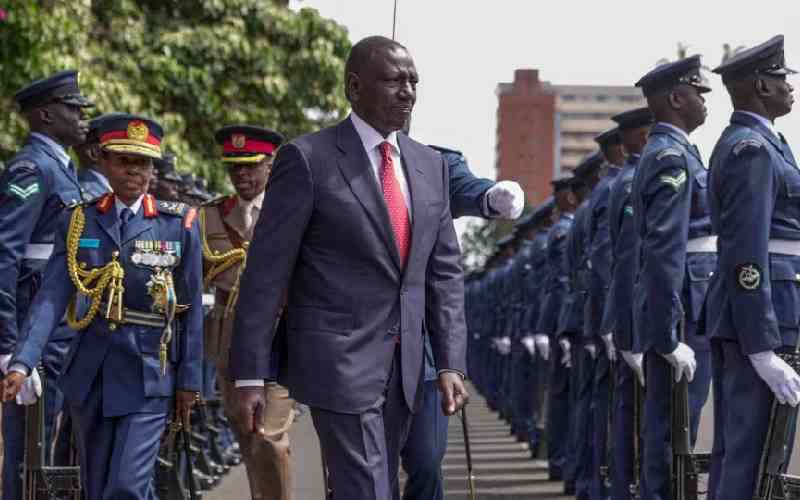A Muslim cleric has asked the government and the United Nations to take a forensic audit the cache of arms recovered from Al Shabaab suspects killed to authenticate their source and have its supplier arrested.
The 11 Al-Shabaab terrorists who had attacked a military camp at Baure in Lamu County on Saturday evening were killed by the Kenya Defense Forces (KDF) after they stormed their camp.
Sheikh Juma Ngao, a Mombasa based cleric said the findings will help to reveal the main sponsors of Al Shabaab.
He said, "The killings were a breakthrough and we hope it will help the government probe where Al Shabaab gets its weapons.This source should be considered and accomplice because they sell them guns knowing it is a killer terror gang."
He also asked the government security forces to seek the help of Interpol to establish where the military uniforms donned by the militia originate.
According to the Inspector General of Police Joseph Boinnet, among the weapons recovered from the killed terrorists were 2,244 rounds of ammunition, three grenades, 12 AK 47 rifles, a rocket propelled grenade and 49 AK47 magazine.Others are two motorolla radios and a video camera which is believed to have been using in documenting the attacks.
Last year, the militia released a video on how they had carried out attacks in Mpeketoni disputing President Uhuru Kenyatta's claim that the killings were a political cleansing.
"The fundamental question is who is the supplier of the uniforms donned by this militia (Al Shabaab)? We also need to know where they source their guns and bullets if we want to bring them down.There is no bullet factory in Somalia and it is time the United Nations came out and interrogated these issues," said Ngao.
Ngao said the radicalisation of youth in the country was as a result of lack of jobs which had created a leeway for the militia. He said Al Shabaab symphathisers lure the young men with a promise of money once they are enlisted.
"Most young men are promised money.They need to be offered jobs to keep them busy," he said.
Ngao also accused Islamic clerics for working with Al Shabaab in radicalising the youth.He said with low pay, the clerics are always ready to hand over the youth to Al Shabaab after being paid handsomely by the militia group.
The group initially had control of the vital port city of Kismayo, where they profited from millions of shilling worth of charcoal exports to finance their activities. But in 2012, Kenyan forces ejected them, dealing a major blow to their finances.
Two months ago, the government closed Hawalas believed to be the main channels for sending money to the group.
Drug trafficking and illegal elephant poaching in the country has been suspected to bolster Al Shabaab in Somalia, contributing up to 40 percent of the gang's economic threshold.
A report by the United States' Bureau for International Narcotics and Law Enforcement Affairs published in March 2015, had indicated that the hawalas were financing terrorism activities.
Stay informed. Subscribe to our newsletter
It claimed that foreign nationals, and in particular the large ethnic Somali resident and refugee populations, were primarily using hawalas to send and receive remittances internationally.
The document list Kenya among major countries where money laundering has thrived adding that despite efforts by the Kenya Revenue Authority, department of the public prosecution and police to combat the vice, Kenya remains vulnerable to money laundering and financial fraud states the report.
"Kenya is a transit point for international drug traffickers. Trade-based money laundering is a problem in Kenya, though the Kenya Revenue Authority has made recent strides in improving internal monitoring and collection procedures," states the report.
 The Standard Group Plc is a
multi-media organization with investments in media platforms spanning newspaper
print operations, television, radio broadcasting, digital and online services. The
Standard Group is recognized as a leading multi-media house in Kenya with a key
influence in matters of national and international interest.
The Standard Group Plc is a
multi-media organization with investments in media platforms spanning newspaper
print operations, television, radio broadcasting, digital and online services. The
Standard Group is recognized as a leading multi-media house in Kenya with a key
influence in matters of national and international interest.
 The Standard Group Plc is a
multi-media organization with investments in media platforms spanning newspaper
print operations, television, radio broadcasting, digital and online services. The
Standard Group is recognized as a leading multi-media house in Kenya with a key
influence in matters of national and international interest.
The Standard Group Plc is a
multi-media organization with investments in media platforms spanning newspaper
print operations, television, radio broadcasting, digital and online services. The
Standard Group is recognized as a leading multi-media house in Kenya with a key
influence in matters of national and international interest.









